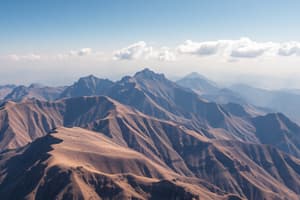Podcast
Questions and Answers
Define the term Geography.
Define the term Geography.
Geography is the study of the Earth's surface, including its physical features, human populations, and the interactions between them.
List and define the two main branches of Geography.
List and define the two main branches of Geography.
The two main branches of Geography are Physical Geography and Human Geography. - Physical Geography focuses on the study of the Earth's natural features, including landforms, climate, soils, and vegetation. - Human Geography examines human populations, their cultures, and their interactions with the environment.
Identify and describe the sub-branches of each main branch.
Identify and describe the sub-branches of each main branch.
Sub-branches of the main branches of Geography are: - Physical Geography: Geomorphology, Hydrology, Quantitative Geography, Cartography, Climatology, Biogeography, - Human Geography: Population Geography, Urban Geography, Economic Geography, Political Geography, Social Geography, Cultural Geography, Quantitative Geography.
Differentiate between the branches and sub-branches.
Differentiate between the branches and sub-branches.
What is the study of the characteristics of human population?
What is the study of the characteristics of human population?
What is the study of administrative divisions of a country?
What is the study of administrative divisions of a country?
What is the study of the characteristics of cities?
What is the study of the characteristics of cities?
What is the use of graphs, tables and numerical data?
What is the use of graphs, tables and numerical data?
What is the study of the conditions of the atmosphere?
What is the study of the conditions of the atmosphere?
What is the study of landforms and the processes that shape them?
What is the study of landforms and the processes that shape them?
What is the study of the properties, distribution, and effects of water?
What is the study of the properties, distribution, and effects of water?
What is the study of the earth and the rocks of which it is composed?
What is the study of the earth and the rocks of which it is composed?
What is the science of map making?
What is the science of map making?
Which sub-branch is found in both Physical Geography and Human Geography?
Which sub-branch is found in both Physical Geography and Human Geography?
Flashcards
Geography Definition
Geography Definition
The study of Earth, people, and their interactions with the environment.
Human Geography
Human Geography
The study of people and their relationship with the environment.
Physical Geography
Physical Geography
The study of the Earth's natural features and systems.
Population Geography
Population Geography
Signup and view all the flashcards
Economic Geography
Economic Geography
Signup and view all the flashcards
Political Geography
Political Geography
Signup and view all the flashcards
Urban Geography
Urban Geography
Signup and view all the flashcards
Geomorphology
Geomorphology
Signup and view all the flashcards
Hydrology
Hydrology
Signup and view all the flashcards
Cartography
Cartography
Signup and view all the flashcards
Geology
Geology
Signup and view all the flashcards
Oceonography
Oceonography
Signup and view all the flashcards
Astronomy
Astronomy
Signup and view all the flashcards
Quantitative Geography
Quantitative Geography
Signup and view all the flashcards
Rainfall map
Rainfall map
Signup and view all the flashcards
Rainfall graph
Rainfall graph
Signup and view all the flashcards
Population map
Population map
Signup and view all the flashcards
Population pyramid
Population pyramid
Signup and view all the flashcards
Study Notes
Defining Geography
- Geography is derived from Greek words meaning "Earth description."
- It's the study of Earth, people, and their interaction with the natural environment.
Branches of Geography
- Two main branches: Physical and Human Geography.
Physical Geography Sub-Branches
- Geomorphology: Study of landforms and the processes creating them.
- Hydrology: Study of water distribution, properties, and effects.
- Oceanography: Study of oceans.
- Meteorology: Study of the atmosphere.
- Cartography: Science of map making.
- Geology: Study of the Earth and rocks.
- Astronomy: Study of celestial bodies.
Human Geography Sub-Branches
- Population Geography: Study of characteristics of human populations.
- Economic Geography: Study of the distribution of economic activities.
- Urban Geography: Study of cities and urban areas.
- Political Geography: Study of political divisions and their influence.
- Tourism: Study of travel and tourism.
- Quantitative Geography: Use of graphs, tables, and numerical data in geography.
Quantitative Geography (Across Both Branches)
- This method uses graphs, tables, and numerical data, applicable to both branches.
- Examples, in Physical Geography: Rainfall maps and graphs.
- Examples, in Human Geography: Population maps and population pyramids.
Studying That Suits You
Use AI to generate personalized quizzes and flashcards to suit your learning preferences.




